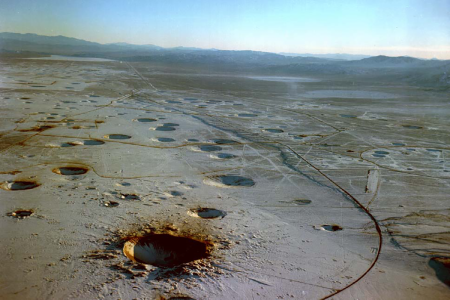The Looming Threat of Renewed U.S. Nuclear Testing
July/August 2024
By Daryl G. Kimball
Most American voters may not realize it, but nuclear weapons testing may be on the ballot in November.

The United States conducted the last of its 1,030 nuclear test explosions in late 1992 just before bipartisan congressional majorities approved legislation halting U.S. nuclear testing and mandating negotiations on a global treaty to ban all nuclear tests.
The treaty has not entered formally into force due to the failure of China, the United States, and a handful of other states to ratify it, but the 1996 Comprehensive Test Ban Treaty (CTBT) effectively has halted nuclear testing worldwide. The only country that conducted a nuclear test explosion in this century is North Korea.
But ahead of the first presidential debate on June 27, Robert O’Brien, a national security adviser under former President Donald Trump, argued in a Foreign Affairs article subtitled “Making the Case for Trump’s Foreign Policy” that “[t]he United States has to maintain technical and numerical superiority to the combined Chinese and Russian nuclear stockpiles. To do so, Washington must test new nuclear weapons for reliability and safety in the real world for the first time since 1992—not just by using computer models.”
Resuming U.S. nuclear testing is technically and militarily unnecessary. Moreover, it would lead to a global chain reaction of nuclear testing, raise global tensions, and blow apart global nonproliferation efforts at a time of heightened nuclear danger.
The vast majority of the 2,056 nuclear test explosions worldwide since 1945 were conducted to develop new and more deadly types of nuclear bombs. The U.S. nuclear weapons labs now have a generously-resourced, highly-developed Stockpile Stewardship Program to maintain the U.S. arsenal.
The program has provided U.S. weapons scientists with a deeper understanding of nuclear weapons dynamics than they had during the nuclear explosive testing era. Simply put, nuclear explosive testing is not needed for “safety and reliability,” according to the most senior National Nuclear Security Administration (NNSA) officials.
O’Brien’s 2024 proposal echoes statements from the Trump administration, which declared in 2018 that the United States did not intend to ratify the CTBT and formally shortened the time necessary to resume nuclear testing from 24 to 36 months to 6 to 10 months. In May 2020, senior Trump national security officials reportedly discussed the idea of a demonstration U.S. nuclear test explosion to try to intimidate China and Russia at the negotiating table. Later that year, Trump’s “arms control” adviser threatened that the United States would spend China and Russia “into oblivion” in a nuclear arms race if they did not accede to U.S. proposals.
The Trump administration’s nuclear testing threats did not soften Chinese or Russian nuclear behavior. In fact, China has accelerated its nuclear weapons buildup, and Russia withdrew its 2000 ratification of the CTBT in 2023 to mirror the U.S. stance. Russian President Vladimir Putin has vowed to resume nuclear testing if the United States does. China, which conducted 45 nuclear test blasts before stopping in 1996, likely would leap at the chance to proof-test new warhead designs if U.S. leaders are dumb enough to resume explosive testing first.
During the 2020 presidential campaign, Joe Biden called the idea of resuming nuclear testing “as reckless as it is dangerous” and asserted that “[w]e have not tested a device since 1992; we don’t need to do so now.” Since Biden took office, his administration has reaffirmed U.S. support for the treaty, but has not taken steps to secure Senate advice and consent for ratification. To help reinforce the global nuclear testing moratorium, in 2023 the head of the NNSA proposed technical talks with Beijing and Moscow on confidence-building arrangements at their former test sites to ensure that their subcritical nuclear experiments are not nuclear test explosions, which would violate the CTBT.
As former Trump administration officials revive talk of nuclear testing, many people who have suffered the toxic effects of radioactive fallout from past U.S. atmospheric nuclear testing continue to wait for Congress to adopt overdue legislation that would extend and expand a program established in 1990 to compensate downwinders suffering from radiation-related health effects.
The program under the Radiation Exposure Compensation Act (RECA) expired on June 7 because House Speaker Mike Johnson (R-La.) refused to allow a vote in the House on a bill passed in the Senate with a strong bipartisan majority that would extend and expand the program to cover affected populations excluded from the original program, including downwinders in New Mexico who were irradiated by the first nuclear test explosion. The bill very likely would win approval in the House, and Biden has said he would sign it.
The era of nuclear testing is a dangerous vestige of the past. Resuming this practice would add insult to the injuries inflicted on U.S. downwinders and undermine global security.
